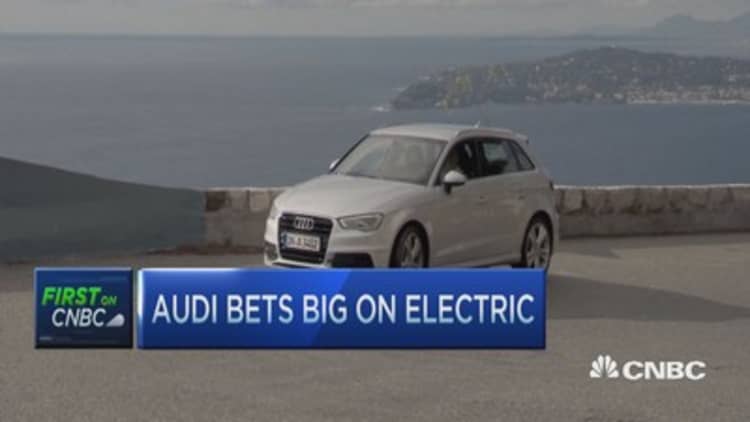The classic car market has been exploding over the past few years, and financial advisors are concerned about protecting their clients' automotive portfolios.
According to the Historic Automobile Group's HAGI "Top Index," the value of rare classic cars has risen nearly 500 percent over the past 10 years. Demand is mushrooming.
"Over the past five years, investors have gotten into the market," said Steve Linden, vintage car appraiser, consultant and author. "Their only goal is to make money. Often they don't even see the cars."
In addition, demand has grown from baby boomers, as well as international buyers across the globe, he said.
A new generation of collectors is emerging, and the market is growing more and more sophisticated, said Dietrich Hatlapa, founder of HAGI and organizer of the annual "Value in the Classic Car Market" conference, held in conjunction with the Dartmouth Tuck School of Business Center for Private Equity and Entrepreneurship.
A presenter at the October 2015 conference — which brought together top auction houses, insurance companies, appraisers, finance companies, dealers and collectors — reported seeing younger collectors going after "younger" cars, such as the Ferrari 288 or BMW M1, he said.
They grew up seeing these emerging classics from the 1970s, '80s, '90s and even the 2000s, with cars such as the Carrera GT, years 2004–2006, Hatlapa said.
Another major trend reported at the conference was the increasing sophistication of the marketplace.
"We're seeing more complex transactions and trends, such as 1031 exchanges, asset-backed lending, and auction houses giving credit lines on future purchases or sales," Hatlapa said.
Protecting automotive portfolios
Advisors want to help their clients safeguard their automotive investments, especially in such a booming and highly nuanced market.
Several years ago, Rob O'Dell, a certified financial planner with Wheaton Wealth Partners, learned that one of his clients was having difficulty finding reliable advice on investing in classic cars.

"I wanted to find him an objective 'automotive fiduciary,'" O'Dell said, as an extension of his own fiduciary responsibility to his clients. "The wealth advisor needs to look outside the box at the total client, whether their holdings include art, wine or autos."
He unexpectedly met Dave Bentson, a fee-only automotive adviser, and introduced him to clients as an objective source of expertise on how to collect and/or invest in classic automobiles.
Classic Car Market Overview
1) Vintage car appraiser, broker and author Steve Linden provided an overview of the classic car market. He categorizes the market by price range:
- $50,000 to $500,000 — affordable potential investment-quality cars. Examples: American muscle cars — Dodge Chargers or Chevelles can range from $30,000 to $70,000; a Jaguar XKE, from $150,000 to $300,000; and a Mercedes Cabriolet, from $275,000 to $400,000.
- $500,000 to $3 million — generally either pre-World War I cars and European exotics of very limited production. Examples: A Maserati Ghibli can range from $300,000 to $800,000; a Lamborghini Miura, from $900,000 to $1.3 million; and a Ferrari 275GPB4, from $2.5 million to $3 million.
- $3 million to $60 million — all European exotics and cars with competition provenance (documented history). Examples: Ferrari Spiders can range from $3 million to more than $50 million.
2) The Big 5 classic car marques in terms of popularity: Ferrari, Porsche, Maserati, Lamborghini and Mercedes.
3) The three main market-driving seasons and events (shows with auctions):
- January: Scottsdale, Arizona
- March: Amelia Island, Florida
- August: Pebble Beach, California
O'Dell has about 10 clients with classic car collections of three to 12 cars, across multiple states. Half are investors, and half are collectors.
"My duty is to preserve and grow my clients' net worth, and an auto portfolio is part of this," he said. "There's an immense cost in not properly maintaining these assets — for example, if you don't service them at the right times, with the right technicians," he explained.
Bentson, founder and principal of Precision Automotive Group, consults with O'Dell's clients on issues such as:
- Fraud, such as misrepresented cars
- Appropriate insurance coverage
- Valuation
- Buying and selling
- Maintenance
- Restoration vs. preservation
This boom has been big for everyone — there's a huge buzz around it. But it's being fueled by big speculation; it's a bubble.Dave Bentsonfounder and principal of Precision Automotive Group
He warns collectors and investors to be wary of where they get advice.
"You've got to know who your car guy is, whether it's an insurance agent, car dealer, broker or mechanic," Bentson said. "How are they compensated, and what are their limitations and experience?"
He is pessimistic about the future of the classic car investment market.
"The current appreciation rate is unsustainable," Bentson said, citing a 1994 Porsche 911 Turbo that went from $55,000 to $300,000 in the past nine months.
"This boom has been big for everyone — there's a huge buzz around it," he said. "But it's being fueled by big speculation; it's a bubble.
"Who's going to be holding the bag when the music stops?" Benston added. "The investor."
— By Deborah Nason, special to CNBC.com







